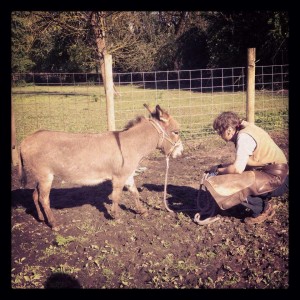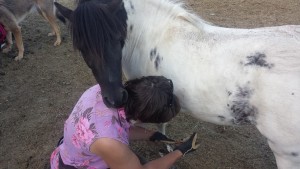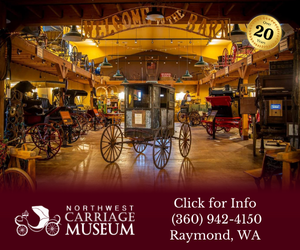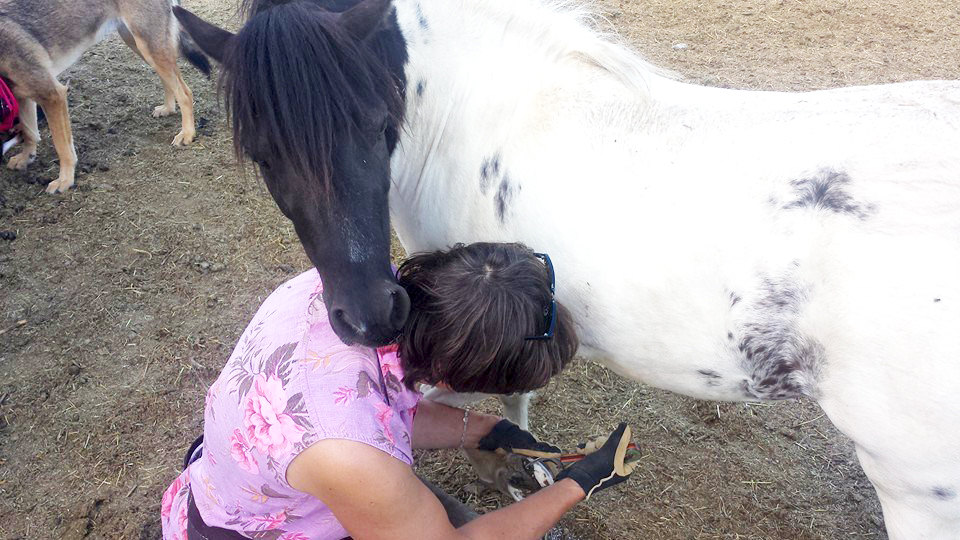Stay Safe Around Equines with these Awareness Practices
by Ute Philippi, farrier

I recently read a post on Facebook about another farrier being kicked by a draft horse. This prompted me to share some awareness practices I have learned over the years working as a farrier. These do not apply only to professionals, they are for everyone and I hope will help others stay safe when sharing close quarters with a horse (or other equine).
When handling horses, I remain very aware of them and what is going on in the environment. These specific “awarenesses” include the following:
Equine Facial Expressions
I pay particular attention to facial expression. If I get a “hard” eye, I stop until it softens. I also ask for feedback from the handler if/when I cannot see the eye as I rely more on eye expression than the position of the ears.
How the Horse Feels As I Work with Them
Is he or she calm? Is the horse agitated or about to become agitated? This can be felt by the slightest movement of the hoof that’s being held up. The clues may be a head turning, a shoulder coming into me, a tail swishing or even the way the animal is breathing. If it gets to a point that I feel the horse is losing focus or becoming troubled, I put the hoof down and step away to assess the situation.
Aware of a Way Out
I must maintain an awareness of where my hoof stand sits, my tools are lying and any barriers/walls nearby. It’s important to know about potential tripping hazards or any objects/humans in the way of my way out, should I need to move away quickly. This also applies to the handlers in the area. They should stand in the safest place possible in case the horse acts up.
Giving the Horse a Way Out
Avoid making horses feel trapped, especially if they are troubled. Allow them to move away if they need to and maintain plenty of room to move with them if it is safe to do so. Young horses, for example, often hop around to figure things out when they are not used to trimming. I go with them and release the leg when they stop moving.
My Balance and Body Awareness
Is my balance good or could the horse easily push me over if it moved in my direction? Where are my feet in relation to the animal to avoid being stepped on if there is sudden movement? What is the traction of the ground surface? Is it safe or unstable? If unstable (slippery, etc.), I find a safer surface to work on.
Awareness of the Handler

Is the handler making the horse troubled, or are they blocking it? Are they paying attention to the equine or are they distracted? Are they preventing the horse from leaning into or away from me? Are they paying attention to its head position? It is much easier for a horse to move into the hoof care provider if the head is turned away from the person because this tends to swing the hind end into the farrier. The horse’s head should always be slightly turned into the direction of the side the hoof care provider is working on. This way, the horse will more likely move its body away from the person rather than into him/her.
Body Language Awareness and Verbal Cues
I avoid yelling because it tends to raise anxiety levels in a horse. Instead, I often laugh and avoid making a behavior a big deal. This helps to lower anxiety levels. I even hum songs to anxious equines to help them calm down. If that does not help to gain focus and cooperation, I step back and reassess the situation. I may walk away until contributing factors are addressed by the owner. Many factors can be at work in these situations including lack of handling and even an unbalanced diet.
Horses communicate in the herd mostly with body language. With this in mind, I am always aware of my own body language. I never want to make a horse feel threatened and try to stay as calm as possible. Deep breathing techniques can be effective to help quiet a horse.
Environmental Awareness
When I show up to work on a horse I am aware of the surroundings: Is a car coming? Are they starting to feed in the barn? Are other horses being turned out, or walking by? Are horses acting up or running in a pasture nearby? Are there kids, dogs or other critters running around? Can the horse easily see what is going on around him or her?
Comfort of the Equine
Is the horse comfortable in the area where he/she is being worked on? Can I make it more comfortable by using a thick, soft pad to stand on or moving them to a different ground surface? Is the animal herd bound?
If a horse does not feel right to me from the start, I will take the time needed to assess the situation. I will work with them a bit (ground work) to see what’s going on and whether or not I can regain their focus. If it still does not feel right/ safe after doing this, I will not work on the horse. It is always best to pay attention to what your intuition is telling you about a situation.
Although a kick without warning can happen, they are generally rare. Horses usually issue a warning first by becoming agitated and/or swishing their tails. They may fidget or try to pull the hoof away. If they do, I stop and find out why. Sometimes the horse just needs a break and it is wise to listen to them!
I also find that introducing myself and taking the time to get to know a horse is much better than just going straight to work. I even do this with horses I know, taking the time to connect first. I work on “horse time,” not people time. Even if they were a bit naughty during the work, I always end on a positive note. Never take a horse’s behavior personally. That alone creates the wrong sort of energy when working with horses.
Work on developing your awareness with horses. It creates a more positive environment and will help you stay safe, and the animals too.
About the author: Ute Philippi is a natural hoof care provider since 2007, and a licensed human and animal bodywork practitioner since 2005. She specializes in fascial release bodywork and barefoot hoof rehabilitation. For more info and case studies, visit her website at: www.balanced-step.com or Balanced-Step.com on Facebook.

The Northwest Horse Source is an independently owned and operated print and online magazine for horse owners and enthusiasts of all breeds and disciplines in the Pacific Northwest. Our contemporary editorial columns are predominantly written by experts in the region, covering the care, training, keeping and enjoyment of horses, with an eye to the specific concerns in our region.








